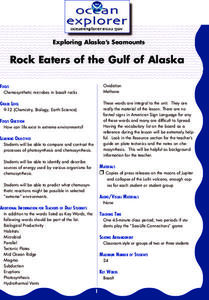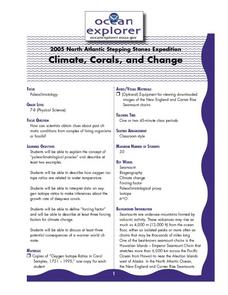Curated OER
Elements of Music
Students identify three of the essential elements of music: rhythm, melody and harmony. They discover a simple song which will illustrate these three elements separately and bring them together in a final form. They analyze and critique...
Curated OER
Reading Between the Lines: Making Inferences About Idioms
Young scholars discover idioms. In this inferencing lesson, students identify idioms from passages and infer meanings of unknown idioms using prior knowledge and experience. Young scholars write sentences using newly learned idioms.
Curated OER
Rock Eaters of the Gulf of Alaska
Students compare and contrast the processes of photosynthesis and chemosynthesis. They identify and describe sources of energy used by various organisms for chemosynthesis.
Curated OER
Sculpture - Textures
Students distinguish between 2D and 3D elements in Escobar's work, explore assemblage, and identify the feelings expressed in Escobar's sculpture.
Curated OER
Starting the School Year off with a Bang!
Student teachers learn the significance of asking questions of their principal and preparing/organizing their classrooms for a successful beginning of their school year.
Curated OER
Burp Under the Ice
Students examine the impact of climate warming on Arctic methane deposits. They identify natural methane processes and describe how this contributes to species extinction. They write reports on their findings.
Curated OER
Try to See It My Way
Pupils participate in a game to identify with other people's points of view. They complete a worksheet about minefields and locate them on a map. They work together in groups to identify why the landmines were placed where they were.
Curated OER
Oral History Memoirs of American Experiences in Japan
Students identify the process of producing an oral history/documentary. Students analyze and synthesize information and memoirs as a valuable tool for exploring the past using primary resources. Students differentiate facts of historical...
Curated OER
Chuukese Dinner (high School)
Students read journal entries about having dinner with a Chuukese family. Using this information, they identify which foods sound appealing and compare and contrast Micronesian and American foods, fruits and vegetables. In groups, they...
Curated OER
Rhythm
Fifth graders listen to a song from a compact disc called "Talking Spirits" and discuss whether they have ever heard music like that before and who might be playing the instruments and the music. They try to identify the instruments...
Curated OER
Lesson Connections
Second graders relate music to history and culture. Also, they listen to songs and identify some characteristics of the music in their own terms. Also listened to is "Chinese Instruments Montage," and then compare what they heard with...
Curated OER
Reconstruction on Life in Virginia
Eighth graders study the life style of Virginians during the Reconstruction Period after the Civil War. They examine how the infrastructure, the economy, and the agricultural status of Virginia and the other Confederate states changed...
Curated OER
Oliver/Kenyon
Young scholars, through two pieces of writing, identify poetic/language devices through the speakers, personification , imagery, metaphor, etc. They assess the patterns those devices are used in and analyze the theme of each. Each...
Curated OER
Trekking to Timbuktu: Mansa Musa Takes a Trip - Student Version
Eleventh graders identify Mansa Musa and discuss his pilgrimage, explain how he related to leaders in the East, and describe decisions he made about his homeland. They discuss changes brought about in Mali as a result of his pilgrimage.
Curated OER
ESL Class Identity
Students work together to identify and research the country and culture of origin for each member of a group in a new ESL class. They organize the researched information in a poster and present their findings to the class.
Curated OER
Volcanoes: Mount Vesuvius
Students explain how volcanoes form. In this earth science lesson, students identify the different types of volcanoes. They create brochures about Mt. Vesuvius before and after the eruption.
Curated OER
Portrait Detectives
Students distinguish portraits from other forms of art and develop their own criteria for analyzing portraits. They discuss what is unique about a portrait, why artists create portraits, and the style of portraits.
Curated OER
Water Around Us
Third graders learn the effects of temperature on the states of water. Then students create paper snowflakes. Finally students complete a computer project with software which teaches the different states of water.
Curated OER
Climate, Corals, and Change
Students examine oxygen isotope ratios and how they are related to water temperature. They also identify three forcing factor changes for climate change.
Curated OER
Just Jelly
Students identify common gelatinous zooplankton in the Canada Basin and their ecological role. They compare and contrast feeding strategies of at least three different types of gelatinous zooplankton.
Curated OER
Students in Article Writing Shocker!
Students examine newspapers to identify the most interesting stories. They discuss the purpose of a headline and complete a worksheet. They write a paper on the differences of writing for different types of publications.
Curated OER
Post-War Japan
Students research the conditions of post-war Japan. In groups, they examine the plans that were put into place for the country and identify the attitude of the Allies. To end the lesson, they discuss the changes that came about in their...
Curated OER
Authors on the Internet
Fifth graders write a list of their favorite authors and illustrators before deciding on ways to learn more about them. They examine print and Internet resources as a way to answer questions they have. They complete an Author Scavenger...
Curated OER
Islam in America
Students examine the cultural and religious diversity within the United States. Using the differences, they discover they are a source of growth and change as well as conflict. They identify the changes that occur when new immigrants...

























